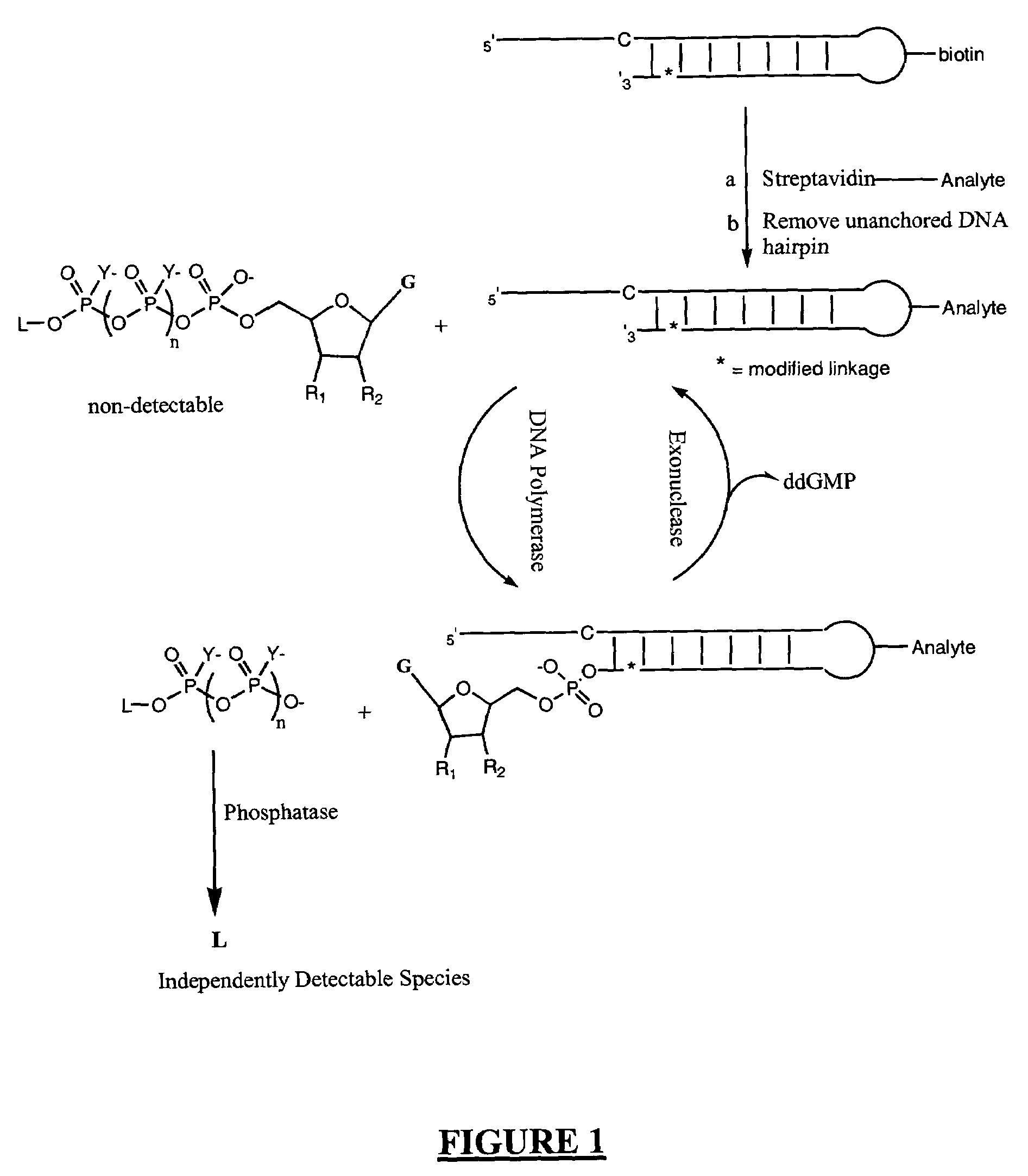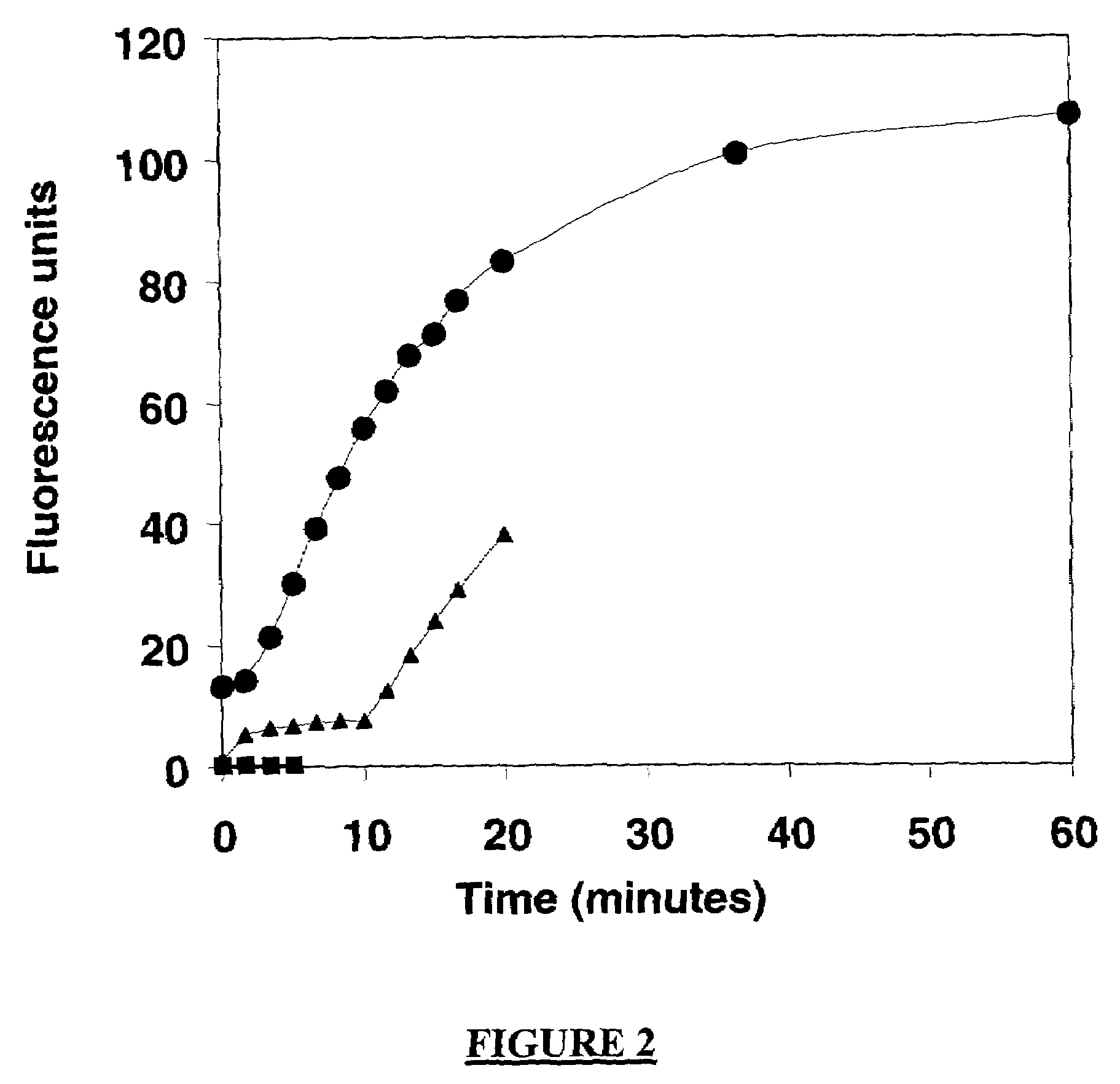Analyte detection
a technology of analyte and detection method, applied in the field of analyte detection, can solve the problems of insufficient quantification due to logarithmic amplification, strict temperature control, and danger of erroneous results
- Summary
- Abstract
- Description
- Claims
- Application Information
AI Technical Summary
Benefits of technology
Problems solved by technology
Method used
Image
Examples
example 1
Preparation of γ(7-Hydroxy-3H-Phenoxazin-3-one)ddGTP (γ-Resorufin-ddGTP)
[0080]ddGTP (125 μl of 86.7 mM solution, 10.8 μmol) was coevaporated with anhydrous DMF (3×0.25 ml). To this, DCC (5 eq.) was added and the mixture was again coevaporated with anhydrous DMF (0.25 ml). Residue was taken in anhydrous DMF (1 ml) and the reaction was stirred at room temperature over a weekend. Resorufin (20 eq.) was coevaporated with anhydrous DMF (2×1 ml) and ddGTP trimetaphosphate from the above cyclization step was added, followed by 20 eq. of triethylamine. After 2 weeks, the reaction mixture was concentrated on a rotary evaporator and the residue was extracted with water (3×2 ml) and filtered. The filtrate was purified on an Xterra RP C18 (19×100 mm) column using 0–30% acetonitrile in 0.1 M triethylammonium bicarbonate (pH 6.7) in 5 column volumes and 30–50% acetonitrile in 1 column volume. The pure fraction was concentrated on a rotavap and coevaporated with methanol (2×5 ml). The residue was ...
example 2
Preparation of γ-(3-Cyanocoumarinyl)ddATP (γCNCoumarin-ddATP)
[0082]ddATP (100 μl of 89 mM solution, >96%) was coevaporated with anhydrous DMF (2×1 ml). To this DCC (9.2 mg, 5 eq.) was added and mixture was again coevaporated with anhydrous DMF (1 ml). Residue was taken in anhydrous DMF (0.5 ml) and reaction was stirred at room temperature. After overnight 7-hydroxy-3-cyanocoumarin (33.3 mg, 20 eq.) and TEA (25 μl, 20 eq.), were added and mixture was stirred at RT. After 1 day, HPLC analysis indicated a major product (55% at 254 nm) at 8.1 min with another minor product at 10 min (˜10%). No significant change occurred after another day. Reaction mixture was concentrated on rotary evaporator and residue was extracted with 3×2 ml water and filtered. Aq solution was concentrated and purified on C18 using 0–30% acetonitrile in 0.1 M TEAB (pH 6.7) in 30 min and 30–50% acetonitrile in 10 min, flow rate 15 ml / min. Main peak was collected in 3 fractions. HPLC of the main peak (fr. 2) showed ...
example 3
Preparation of δ-9H(1,3-dichloro-9,9-dimethylacridin-2-one-7-yl)-dideoxythymidine-5′-tetraphosphate (ddT4P-DDAO)
[0084]ddTTP (100 μl of 80 mM solution) was coevaporated with anhydrous dimethylformamide (DMF, 2×1 ml). To this dicyclohexylcarbodimide (8.3 mg. 5 eq.) was added and the mixture was again coevaporated with anhydrous DMF (1 ml). Residue was taken in anhydrous DMF (1 ml) and reaction was stirred at room temperature overnight. HPLC showed mostly cyclized triphosphate (˜82%). Reaction mixture was concentrated and residue was washed with anhydrous diethyl ether 3×. It was redissolved in anhydrous DMF and concentrated to dryness on rotavap. Residue was taken with DDAO-monophosphate, ammonium salt (5 mg, 1.5 eq.) in 200 μl anhydrous DMF and stirred at 40° C. over the weekend. HPLC showed formation of a new product with desired UV characteristics at 11.96 min. (HPLC Method: 0.30% acetonitrile in 0.1 M triethylammonium acetate (pH 7) in 15 min, and 30–50% acetonitrile in 5 min, Nov...
PUM
| Property | Measurement | Unit |
|---|---|---|
| pH | aaaaa | aaaaa |
| pH | aaaaa | aaaaa |
| flow rate | aaaaa | aaaaa |
Abstract
Description
Claims
Application Information
 Login to View More
Login to View More - R&D
- Intellectual Property
- Life Sciences
- Materials
- Tech Scout
- Unparalleled Data Quality
- Higher Quality Content
- 60% Fewer Hallucinations
Browse by: Latest US Patents, China's latest patents, Technical Efficacy Thesaurus, Application Domain, Technology Topic, Popular Technical Reports.
© 2025 PatSnap. All rights reserved.Legal|Privacy policy|Modern Slavery Act Transparency Statement|Sitemap|About US| Contact US: help@patsnap.com



